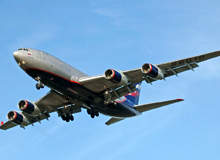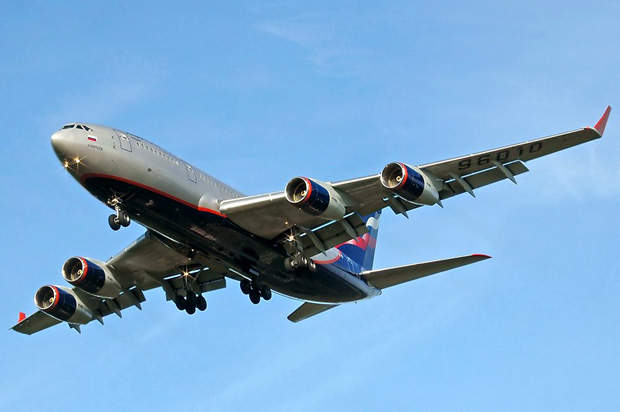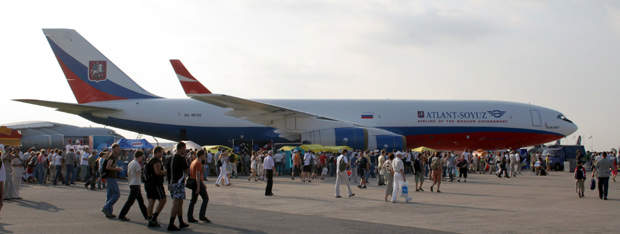The Ilyushin Il-96 is a Russian long-haul wide-body aircraft that is powered by four engines. Designed by Russian aircraft designer Sergey V Ilyushin, the aircraft is manufactured by Voronezh Aircraft Production Association.
Ilyushin Il-96 can be used as a passenger or cargo aircraft, and can accommodate between 235 and 436 passengers. The aircraft features a new type of wing layout and the fuselage of the aircraft is approximately 4m shorter than its predecessor, the Il-86 aircraft.
The maiden flight of the Il-96 aircraft was on 28 September 1988. It was certified in 1992 and the first Ilyushin Il-96 entered service in July 1993 with Aeroflot Russian International Airlines.
The lifetime of the aircraft is 20 years or 20,000 landings or 60,000 flying hours. Il-96 was formerly used by Vladimir Putin and currently being used by Russian President Dmitri Medvedev.
Ilyushin Il-96 orders and deliveries
Il-96 is a Russian long-haul wide-body aircraft that is powered by four engines.”
As of June 2009, a total of 21 Ilyushin Il-96 airliners were in service with 12 more in order. Airlines that are using the aircraft are Rossiya (four in service, one on order), Ilyushin Design Bureau (one in service), KrasAir (two in service), Iran Air (six on order), Atlant-Soyuz Airlines (two on order), Aeroflot (six in service), Cubana (three in service, one on order), Clean Air (two on order), Polet (two in service, one on order), Conviasa (two on order) and another Russian airline (five in service).
Il-96 variants
The major variants of the Ilyushin Il-96 airplane include Il-96-300, Il-96M/T and Il-96-400. The Il-96-300, Il-96M, Il-96-400 and Il-96-400M are passenger aircraft, while the Il-96T and Il-96-400T are cargo aircraft.
The launch of Il-96-300 was on 1985 and it entered into service in 1993. Il-96M was launched in 1993 and put into service in 2000. The Il-96-300 can accommodate 262 passengers, three crew and 12 flight attendants. On 11 August 2009, Russian Minister of Industry and Trade Viktor Khristenko announced that the Russain Aviation Industry would stop manufacturing Il-96-300.
Il-96M is a passenger aircraft that does not require a flight engineer. It is designed to be operatedby a crew of two. The Il-96-400 is modelled on the Il-96M/T fuselage with a range of 10,000km and a passenger capacity of 436. A two-class configuration can accommodate 386 passengers and a three-class configuration the aircraft has space for 315 passengers.
The Il-96-400T is a high payload, cargo aircraft, stretched by 9.35m companred with the Il-96-300 with the capacity of the cargo compartment being 776m³ and a maximum cargo weight of 92t. Another variant of the Il-96 aircraft, the Il-96-400M, is a passenger airplane.
A future airplane development project Il-96MK is currently under study. Ducted engines in the 175kN to 195kN (38,000lb to 43,000lb) thrust class could power this future airplane.
Design and features
The Il-96 design is a modification of the previous Il-86 with advancement in features such as the introduction of new turbofan engines, and increased take-off weight, wingspan and fuel capacity among other developments.
The Ilyushin Il-96 wings are supercritical and equipped with winglets. The aircraft incorporates a triplex fly-by-wire control system – an advanced flight control system consisting of redundant computers. Ilyushin Il-96 features a flight management system (FMS), an inertial and satellite navigation system and collision air avoidance system (CAS) containing mode S transponders.
Il-96 entered service in July 1993 with Aeroflot Russian International Airlines.”
LCDs on the airplane depict onboard operations information, and details piloting and navigation systems. A computer-aided control supported by the electrical-hydraulic system with a back up artificial mechanical channel insures the airplane.
Passenger airliner Il-96M and freighter Il-96T are modern developments of the Il-96-300 with the fuselage streched in both aircraft. Il-96M is 15t heavier than Il-96-300, fitted with western-style avionics and range with 312 passengers in a three-class configuration or 92t payload is about 10,400km.
The Il-96-400T has a 776m³ cargo compartment and can carry up to 92t of cargo. Three cargo doors provide way for loading the cargo. Roller equipment on the floor of the cargo compartment can hold automatic loading devices for easier cargo towing. A restroom for the crew at the front of the aircraft's deck has a galley, toilet and beds.
Cabin
The Il-96-300 cabin layout accommodates 262 passengers, with 18 seats of 54in pitch and 244 seats of 32in pitch. Galleys are positioned on the upper deck, 16 LD-3 containers and crew restroom are situated in the lower deck. Another 289 seats layout specification was done by increasing the seats in the business class section from 18 to 44 with 34in pitch.
Engines
Il-96-300 aircraft uses four two-shaft PS-90A turbofan engines with a thrust rating of 16,000kgf (157kN, 35,300lbf) and developed by Perm Motors Holding, Russia. The design of the PS-90A is twin-spool, high-bypass-ratio turbofan with fan and core airflows mixing. The engine has 11 modules, noise suppression system and a thrust reverser which is present in the fan duct. The airplane also includes an auxiliary power unit VSU-10-02 which is constructed by Baranov Manufacturing Union,
Russia.
The PS-90A engine was certified in 1992 and complies with ICAO stage 3 noise limits. The fuel consumption of this engine is 0.595kg/kgf an hour. The flight altitude supported is up to 13,100m.
Il-96-400T uses an advanced PS-90A1 engine which is similar in design to the two-shaft PS-90A turbofan except the fact that this modern engine has a thrust rating of up to 17,400kgf. The model of aircraft is also fitted with the same auxiliary power unit as in the Il-96-300.
Il-96M and Il-96T are propelled by Pratt & Whitney PW 2337 engines with a thrust rating of 165kN (37,000lbf). The modern turbofan engines include a fan, compressors, turbines, combustion chamber and an exhaust nozzle. All the components play a crucial role and develop thrust which in turn propels the aircraft forward.
Il-96 avionics
The avionic systems in the Ilyushin Il-96 are modern systems made in Russia and they comply with the ICAO standards. The aircraft is equipped with Collins digital avionics.
A six-screen electronic flight instrument system (EFIS) functions as the flightdeck instrument display system which incorporates an early ground proximity warning system (GPWS) and displays weather radar data as well. Communication and navigation in Il-96 is done with the help of a control panel KPRTS-95М-1, which is incorporated within the aircraft.
The airplane is managed with the help of a VSS-95-1V flight management system. The system complies with RNP-1 requirements whereas database loading is done according to ARINC-424.
The Il-96 electronic indication systems are SEI-85М and KISS-1-2МA. The aircraft is equipped with a terrain relief system SRPBZ. Il-96 houses an air collision avoidance system CAS-81A (or SPS-2000) and a satellite communication system Aero mini M or Aero I.






